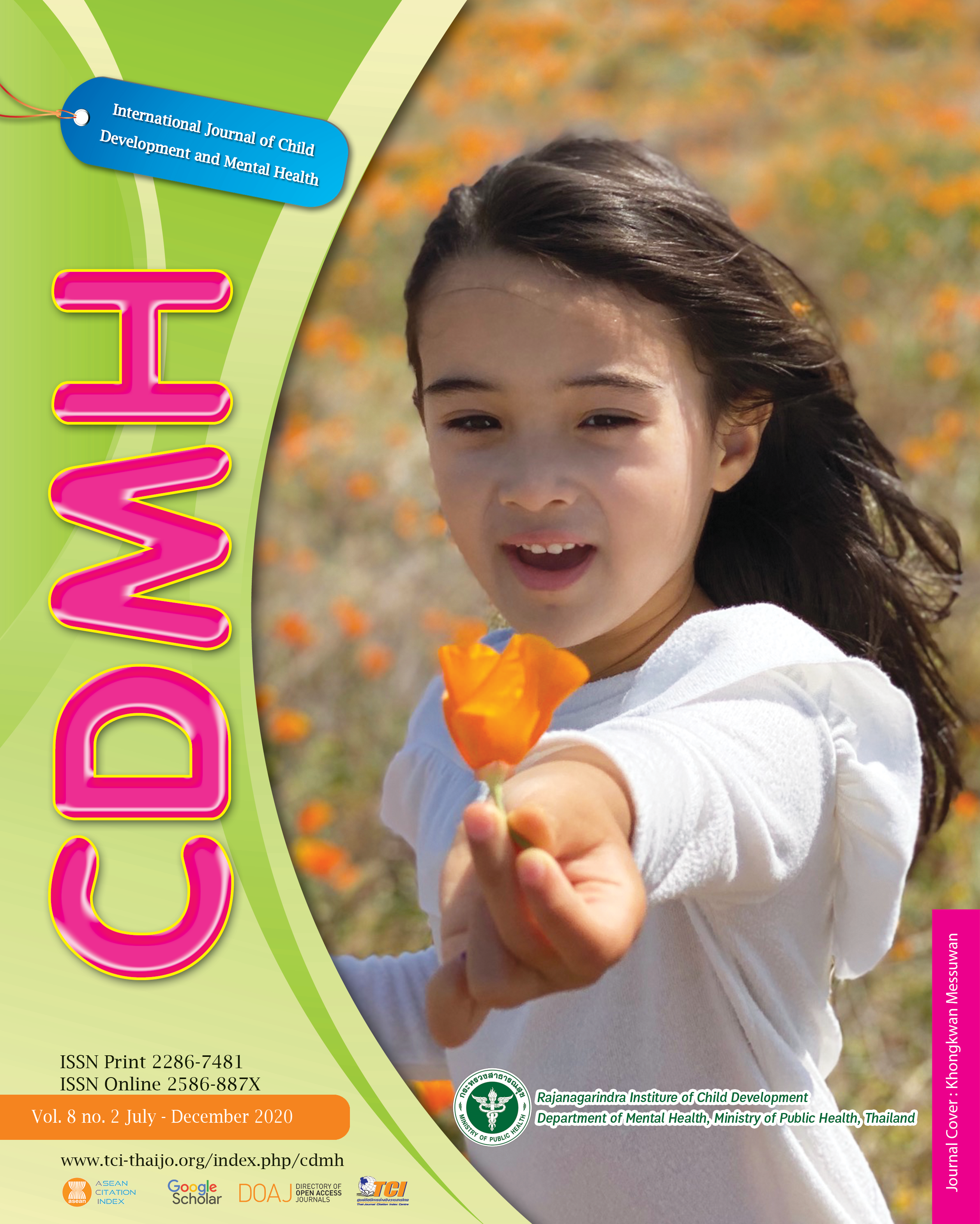Designing the Social Stories for Reducing Undesirable Eating Behavior Among People with Autism : A Case Study Reducing Undesirable Eating Behavior among People with Autism
Main Article Content
Abstract
This study aimed to design a Social Story, based on Gray, that reduces undesirable eating behaviours among individuals with autism and compare their behaviours before and after the intervention. It was conducted in three subjects with autism, using the ABAB reversal single-subject design. Undesirable eating behaviours were observed and then they were used to developed Social Story in line with Gray’s three steps. The tools underwent quality testing in both the content validity and the pilot implementation to check the language and understanding in an individual with autism who was similar to the subjects. The data was then analysed using descriptive statistics. The developed Social Story consisted of five pages, containing five images and five sentences. After using the developed Social Story, the reduction of undesirable eating behaviours occured in Case 1, 2 and 3 in all four phases of the study. In Phase 1, in the baseline data was gathered, the average occurrences of the behaviours were 13.50%, 11.83% and 10.00%, respectively. Then, in Phase 2, the first treatment phase (B1), the average occurrences were 10.83%, 8.54% and 7.83% respectively. Then, in Phase 3, the intervention withdrawal, they were 9.42%, 5.92% and 8.33% respectively. In Phase 4, the second treatment phase, the percentages reduced to 7.42, 5.58 and 6.30, respectively. This study proves that the designed Social Story was effective in reducing undesirable eating behaviours in people with autism and should be adapted and applied to others with the same behaviours as appropriate. Further studies can be done on the effectiveness of Social Story in supporting people with autism in other aspects such as enhancing social skills and interaction, reducing other undesirable behaviours or even developing Social Story e-books.
Article Details
![]()
Creative Commons License
This work is licensed under a Creative Commons Attribution-NonCommercial-No Derivatives 4.0 International (CC BY-NC-ND 4.0)
The authors retain copyright and permit the journal the copyright of first publication
Articles, once having passed the review process and accepted for publication in the CDMH Journal, are copyrighted under the CDMH Journal, Department of Mental Health, Ministry of Public Health. Please be aware distribution of CDMH Journal content for commercial purposes without permission is expressly prohibited. However, distribution with intent to educate, advocate, or spread awareness within the general public and research communities is permitted and encouraged with the understanding that the CDMH Journal Editorial Board do not hold jurisdiction or liability for any accompanying comments, text, or information from third parties, either in favor for or against the original article’s assertions, conclusions, methodology, or content.
References
Chantra Rungnapa. (2009). Quality of life of caregivers with autism. Journal of Nursing, Ministry of Public Health, 20(1), 72-84.
Child Development Center the Northern Region. (2005). Integrated Child Care Handbook with Autism, Volume 4, Behavior Adjustment Co-learning and caring for children with autism. Chiang Mai: Somporn Printing.
Department of mental health. (2016). Prevalence of Autistic in population. Retrieved 24 March
From http://statv2.nic.go.th/Health/05020203_06.php.
Doss, A. (2013). Social Story Intervention for Children with Autism to Decrease Challenging Behavior during Homework (master’s thesis). The Honors College. USA.
Gray, C. (2014). Social Story. Retrieved 6 June 2018 from https://carolgraysocialstories.com/social-stories/.
Hartmann, D. P. (1977). Considerations in the choice of interobserver reliability estimates. Journal of applied behavior analysis, 10(1), 103-116.
Iamsupasit Sompoch. (2013). Theories and techniques of behavior modification. Bangkok: Chulalongkorn University.
Lotrakul Manote & Sukanich Pramote. (2015). Ramathibodi Psychiatry (4th edition). Bangkok: Department of Psychiatry. Faculty of Medicine Ramathibodi Hospital, Mahidol University.
Mcdonald, N. (2014). Food Selectivity And Weight Status In Children With An Autism Spectrum Disorder (Doctoral dissertation). Colorado State University. USA.
Mohammed, A., & Mostafa, A. (2012). The Effect of Social Story intervention Technique on Self -Management of Eating Behavior of a Child with Autism. International Journal of Psycho-Educational Sciences, 1(1), 32-43.
Polit, D.F., & Beck, C.T. (2006). The content validity index: Are you sure you know what’s being reported?. Critique and recommendations [Electronic version]. Research in Nursing & Health, 29(5), 489-497.
Reynolds, C. R., & Kamphaus, R. W. (2013). Autism Spectrum Disorder. Retrieved from https://images. pearsonclinical.com/images/assets/basc3/basc-3resources/DSM5_Diagnostic Criteria_AutismSpectrumDisorder.pdf.
Sirirutraykha Thaweesak. (2018). An integrated approach to autism care. Retrieved 16 August 2018
From http://www.specialchild. psu.ac.th/artical/41-autism/69-2011-02-07-06-45-16.html.
Tawankarnjanachot Nadlada. (2016). Social skills for school-age children. Journal of Psychiatric
Nursing and Mental Health, 30(2), 1-21.
Wheeler, M. (2018). Mealtime and children on the Autism Spectrum: Beyond Picky, Fussy, and Fads. Retrieved 6 July 2018 from https://www.iidc.indiana.edu/pages/mealtime-and-children-on-the-autism-spectrum-beyond-picky-fussy-and-fads.


